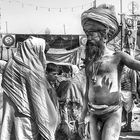The Emperor has No Clothes
One of the interesting things about Religious personalities while walking in the streets with a little camera is seeing how so much of life can fit into fairy tales from centuries past. A guru walks threw the make shift city for the Kumbh Mela and a child mentions he has no clothes on. he Guru reacts, throws up his hand and continues to stride on. Nudity in his version of the hindu religion is his version of being pure. Then again in Arizona in an area of the bible belt , christians cam to blow attempting to be distinguishing by comments which compared to the other christian organization who's brand of faith was better by the inclusion or exclusion of women in the role of service and practicing as practitioner. This boasting turned into a show down of violence.
What they needed was the innocence of a young child to say the facts as they are. *1
*1"The Emperor's New Clothes is a Danish fairy tale written by Hans Christian Andersen and first published in 1837, as part of Eventyr, Fortalte for Born (Fairy Tales, Told for Children). It was originally known as Keiserens Nye Klæder.
Plot synopsis
Many years ago there lived an emperor who cared only about his clothes and about showing them off. One day he heard from two swindlers that they could make the finest suit of clothes from the most beautiful cloth. This cloth, they said, also had the special capability that it was invisible to anyone who was either stupid or not fit for his position.
Being a bit nervous about whether he himself would be able to see the cloth, the emperor first sent two of his trusted men to see it. Of course, neither would admit that they could not see the cloth and so praised it. All the townspeople had also heard of the cloth and were interested to learn how stupid their neighbors were.
The emperor then allowed himself to be dressed in the clothes for a procession through town, never admitting that he was too unfit and stupid to see what he was wearing. For he was afraid that the other people would think that he was stupid.
Of course, all the townspeople wildly praised the magnificent clothes of the emperor, afraid to admit that they could not see them, until a small child said:
"But he has nothing on"!
This was whispered from person to person until everyone in the crowd was shouting that the emperor had nothing on. The emperor heard it and felt that they were correct, but held his head high and finished the procession.
Origins
It has been claimed that Andersen's original source was a Spanish story recorded by Don Juan Manuel (1282-1348).
Analysis
This story of the little boy puncturing the pretensions of the emperor's court has parallels from other cultures, categorized as Aarne-Thompson folktale type 1620.
The expressions The Emperor's new clothes and The Emperor has no clothes are often used with allusion to Andersen's tale. Most frequently, the metaphor involves a situation wherein the overwhelming (usually unempowered) majority of observers willingly share in a collective ignorance of an obvious fact, despite individually recognising the absurdity. A similar twentieth-century metaphor is the Elephant in the room.
The story is also used to express a concept of "truth seen by the eyes of a child", an idea that truth is often spoken by a person too naïve to understand group pressures to see contrary to the obvious. This is a general theme of "purity within innocence" throughout Andersen's fables and many similar works of literature.
"The Emperor Wears No Clothes" or "The Emperor Has No Clothes" is often used in political and social contexts for any obvious truth denied by the majority despite the evidence of their eyes, especially when proclaimed by the government. Amazon.com alone lists 17 works with one of these two phrases in the title, and this ignores political magazine articles and non-mainstream authors"










u-c-g 08/09/2013 1:26
great pic!:-)
MissNeugier 24/07/2013 17:55
Thank you for your explanations to your photos, always interestingDel-Hor 24/03/2013 23:38
I know the story of the king! We can fit it in that man and also now days :-)Also old, is the simbol left of his face, sadly the nazi use it for their one benefit.
As usual great and strong photo.
Best Regards.
DH
Frederick Mann 23/03/2013 14:06
thanks for the story.. the description.. helps me to understand.. an other world
Ygar 23/03/2013 9:39
Impressive image!!!! Regards!Ratko Nedovic 22/03/2013 19:38
Another one good photo-story.From which is this shadow on his stomach?
I think it isn't from his hand.
Ratko
Heidi Roloff 22/03/2013 12:06
Your pic is not only great, it is also the perfect illustration to the old fairy tale well known even in Germany. I love both of them :-))Greetings from Heidi
Tania Skaradek 22/03/2013 10:51
Glenn you are right! Each story contains a hint, a lesson to the reader or listener.For many centuries the wise old men told stories to their grandchildren ... and thus teaching them life.
Perhaps we, the adults and clever, should read stories at least occasionally, not to give ourselves to forget the simple truths of life:-)
Regards
Tania
rschaefer 22/03/2013 10:38
Thanks for sharing your pic, information and thoughts...Very interesting. Makes me think...
Greetings, Rebecca
F. Rodriguez 22/03/2013 6:54
very good one. thanks!JamSen 22/03/2013 5:45
strangebut very interesting....
a great documentation
greetings Werner